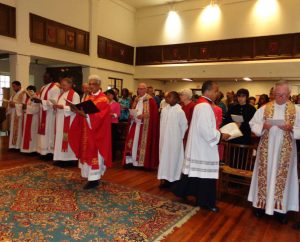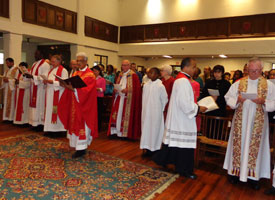By Jeni Miller
While the Missouri Synod as we know it today was not organized until 1847 — as the German Evangelical Lutheran Synod of Missouri, Ohio and Other States — one East Coast LCMS congregation this year celebrates its 350th anniversary.
How is that possible?
The Evangelical Lutheran Church of St. Matthew in New York City traces its history back to the Congregation of the Unaltered Augsburg Confession of Faith, chartered Dec. 6, 1664.
St. Matthew’s website notes that the congregation is “America’s oldest Lutheran church,” though the church didn’t join the LCMS until a couple of centuries after its charter.

The Rev. Peter Deebrah, the current and 54th pastor of St. Matthew, which is in northern Manhattan, is quite ecstatic about this 350th anniversary, as is his congregation.
“As a small group of people that belongs to the larger body of Christ, the people of St. Matthew feel special and honored that God has brought us to this time in our history,” explained Deebrah.
Taking root
Like many institutions that have seen the dawn of several ages, St. Matthew has a varied and at some points dramatic history.
In the 1640s, among the Dutch colony of New Amsterdam in the colonial period of the nation, the Congregation of the Unaltered Augsburg Confession of Faith was formed. However, this budding church was without a pastor. After placing their request with the mother church in Amsterdam, they finally received a shepherd — more than a decade later.
Unfortunately, due to the harsh laws in this colony on the island of Manhattan, they were prevented from practicing their Christian faith in keeping with the Augsburg Confession, and their long-awaited pastor was soon caught and deported. After the British took control of the colony in September 1664 and renamed it New York, the governor issued the congregation’s charter, granting them the right to freely express and maintain their Lutheran identity and practice.
Through the years that followed, the church was able to obtain a building and could worship without fear of being jailed, fined or worse. Unfortunately, the congregation had some occasional turnover in the pastorate, at one point experiencing another 10-year pastoral vacancy. In 1703, however, they were blessed with the service of Rev. Justus Falckner of Germany, the first Lutheran minister ordained in America.
Further in the future, perhaps one of the more dramatic conflicts in St. Matthew’s history included a battle over language. The congregation had changed — relative to the community it was serving — in meeting the needs of the waves of Lutheran immigrants who were coming from Germany. The larger group of German-speaking members asked the Dutch-speaking leaders of the congregation to allow worship services to be held in German. But the leaders refused, leading to the withdrawal of a group of German members to form another congregation by the name of Christ Church.
During this language struggle, Henry Melchior Muhlenburg, who is considered the “patriarch” of Lutheranism in America, was called to serve the “old church.” The division between the churches lasted until 1784, when the two congregations finally reunited. Through it all, in 1822, the English congregation of St. Matthew was started, and later in the 19th century it would continue to support day schools, plant churches and even found the ministry that is now Concordia College—New York, Bronxville, N.Y.
In 1885, as St. Matthew was among the most conservative of Lutheran churches on the East Coast, the church joined the Evangelical Lutheran Synod of Missouri, Ohio and other States, now the LCMS. According to Deebrah, the reason St. Matthew chose to join the LCMS at that time was because of “the need to remain confessional in the midst of the polemics at that time in history.”
St. Matthew contributed significantly to the growth of Lutheranism in New York, New Jersey, New England, and on Long Island, supporting more than a dozen new congregations in that region. Throughout many moves, pastorates, conflicts and even reunions, the congregation that exists today continues to carry out Christ’s work in its community and faithfully receives the Lord’s gifts of Word and Sacrament.
“Recalling the roots of our church tells of our beginnings, as the people of the Old Testament are always reminded of the call of Abraham and the promise to the patriarchs that is fulfilled in every generation of all who call upon the name of the Lord,” said Deebrah. “Like every nation, family or organization, in knowing our beginnings and our journey through the past into the present awakens us to the reality of who we truly are. History provides that opportunity to know and learn from our forbears and makes us more appreciative of the legacy that is gifted to us so that we might treasure the gift and seek to pass it on to those who will follow us.”
Anniversary events
St. Matthew is celebrating its 350th anniversary with a series of worship services, concerts, exhibits and panel discussions from September through December.
The celebration began with an “inaugural worship service” and fellowship dinner Sept. 21, with the Rev. Dr. David H. Benke, president of the LCMS Atlantic District, preaching for the service. During the dinner’s reception, the church also debuted a limited-edition commemorative medallion, specifically developed for the anniversary.
Upcoming events include a celebration concert at the church, Nov. 2 at 4:30 p.m., featuring choirs from Concordia, Bronxville, and local Lutheran congregations; a display of St. Matthew’s historical artifacts, Oct. 17-Nov. 7 at Concordia, Bronxville’s, Scheele Memorial Library; a panel discussion on “Lutheranism in America — Past, Present and Future,” Nov 6, at 7-9 p.m, in the Krenz Academic Center at Concordia, Bronxville; and a “350th anniversary of charter worship and fellowship celebration” at noon on Dec. 6.
“Worship around Word and Sacrament [continues] what was sought after and realized in 1664 by our spiritual forebears — our gathering freely in singing with the angels the hymns of glory to God who comes to us [through] the means of grace,” said Deebrah.
“We look forward to celebrating this time in the life of Lutheranism in America and also our congregation. The center of it all is worship — as the people of God our worship is in response to what He has done for us. As it says in Psalm 90 (v.1-2), ‘Lord, You have been our dwelling place in all generations. Before the mountains were brought forth, or ever You had formed the earth and the world, from everlasting to everlasting You are God.’ Sharing our story — which is the story of Jesus — in and through our congregation over these three and a half centuries, for which we are grateful to our forebears and to God, is what we most look forward to during this celebration of 350 years.”
For information about St. Matthew’s history and 350th anniversary celebration, visit stmatthewnyc.org or contact Deebrah at petedeebrah@aol.com or (212) 567-5948.
Jeni Miller is a freelance writer and member of Lutheran Church of the Ascension, Atlanta.
Posted Oct. 1, 2014 / Updated Oct. 1, 2014
